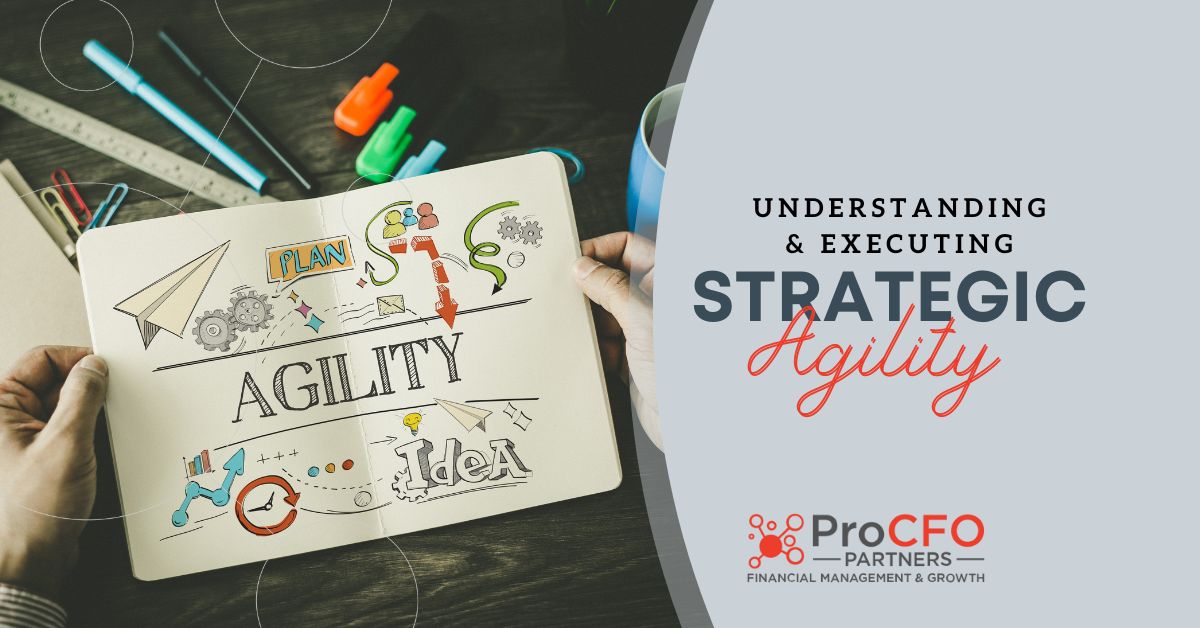Understanding and Executing Strategic Agility
Jul 27, 2022
Agility in business is the ability to move fast. Strategic agility is moving fast with purpose. In this article, we’ll discuss the value of being strategically agile. Not all organizations are designed for moving fast – yet market dynamics (and customers!) expect it. And those that can move fast often do so without a vision for future impact. Learn to understand how strategic agility has a crucial role in your organization’s ability to compete, innovate, flex and ultimately achieve new goals more quickly and efficiently.
Quick note – we’re not specifically discussing Agile management processes and methodologies per se, which involve processes like self-governing teams, Scrums, Sprints, Standups and more. This article is conceptually broad on the topics of agility. However, by definition those companies that do adopt Agile processes are following the concepts we’ll discuss here.
What is Business Agility?
Business agility is a company’s capability for reacting quickly and effectively to changes in their environment, including new technologies and customer needs.
Business agility allows organizations to adapt quickly to new opportunities, challenges, and market dynamics. Business agility is also closely linked with innovation and creativity as well as organizational culture.
Four components of business agility include:
- Adaptability: The capacity to change or modify behavior, systems and processes in response to new information, or new situations. Adaptability may be seen as a key component of resilience.
- Innovation: The process of developing new ideas, products, or processes. Through innovation, the way things are done changes, in order to make them better.
- Flexibility: The capacity for adjustment or versatility. The need for flexibility is a consequence of uncertainty and variability in the business environment. Flexibility and adaptability are close cousins.
- Resilience: The ability of a company to bounce back from an event or setback and continue to grow. The resilience of an organization depends on its ability to anticipate and manage risks associated with its activities. Resilient organizations usually have a robust organizational structure and governance, as well as a culture that promotes innovation and flexibility. In other words, not all agile businesses are resilient, but most resilient companies have the capacity to be agile.
If you identify with one or two bullets of business agility, you’re like most companies.
- Most organizations do some things well, or well enough, where agility is concerned.
- Most organizations also inflate or overestimate their abilities where agility is concerned.
Being agile is not something you declare you are as a company. It’s an outcome of specific systems, processes and cultural characteristics you’ve adopted.
Adopting these systems is easier for some companies than for others. A brand new start-up has the advantage of defining its culture and infrastructure from inception in implementing agile frameworks and systems. What they may lack, however, is a strong and stable foundation of market presence, successful revenue models, predictable cash flow, Key Performance Indicators (KPIs) and other advantages that an older or more established business may have. The benefit of a strong foundation is it allows time and resources to dedicate to becoming adaptable, innovative, flexible and resilient.
The flip side of having an established, strong foundation is these are often characteristics of older organizations that have an entrenched culture, market or industry reputation, people and leadership dynamics and more that can make it difficult to respond quickly or nimbly to situations. You’ve heard the expression “like trying to turn the Titanic around,” – it’s apropos to this context.
What is Strategic Agility
The concept of strategic agility describes how companies can react quickly and often proactively to changes in the environment. Strategic agility generally means being able to experiment, learn, and adapt faster than competitors do.
Where agile companies are capable of moving swiftly, companies that are strategically agile choose to approach each day and decision with a mindset of innovation, resiliency, flexibility and adaptation. This means integrating agile concepts into their KPIs, culture, hiring decisions and company culture. (This is also where Agile management processes, touched on earlier, support strategic intention.)
Strategic agility includes tactical and adaptive capabilities.
- Adaptive strategic agility is characterized by a high level of flexibility in strategy and the ability to respond quickly to changes in the environment.
- Tactical strategic agility, on the other hand, refers to short-term changes in strategy that are not based on any fundamental change in the environment.
Characteristics of Strategic Agility include being:
- Customer-centric and value driven.
- Committed to continuous improvement and learning.
- Communicative, collaborative, and participative with stakeholders.
Key points for implementing strategic agility include:
- Creating a culture of experimentation
- Building a learning organization
- Developing leadership skills
Hey, great list! No company intentionally does not want more of these capabilities. Yes, that’s assumed. Wanting does not create a strategically agile organization. Again, agility like we’re discussing is the outcome of adopting the right systems and processes, company-wide, to achieve intentional results. This brings us back to some of those challenges to adoption.
The Challenge and Charge for Adopting Strategic Agility
Guidance for older or larger businesses wanting to become strategically agile:
- Culture and strategy do not come from the bottom up. Becoming agile starts with leaders developing mindsets and skill sets conditioned for agility. If your company is used to having decisions go through four committees with six reports that take seven months to complete, you have work to do.
- Be willing to experiment. This means failure is imminent where certain projects or ideas are concerned. Be an organization that doesn’t discourage “safe” failures – they present excellent learning opportunities. An advantage of a more stable business is withstanding relatively small risks that could lead to significant payoffs.
- Research best practices, including Agile management processes.
- Dedicate Key Performance Indicators to help you measure agility or become agile. This can be temporal, like shortening the window from idea to execution. It can be cumulative, like how many new ideas are being innovated. Look for guidance from other professionals on what your company KPIs might look like.
Guidance for smaller or younger companies:
- Seek like-minded investors and leaders who have agile mindsets or experience with Agile practices
- Develop best practices and KPI’s that codify or systematize agility from the start. The process of going from idea to MVP (Minimum Viable Product) or proof of concept should be predictable and designed to adapt or change with little time or consequence.
- But be aware of the consequences. Your organization probably doesn’t have the cash flow, revenue or reputation to be constantly tinkering. And tinkering can, if left unchecked, become its own objective where delivery or shipping the thing takes a backseat to “getting it right.” Agile companies find the right compromise of present is better than perfect.
- Have agility in growth and scale be top of mind. A five-person team will naturally be far more capable of moving quicker than a 500-person team. This is where agile systems, integrated early on, will make for a company with strategical agility baked into its DNA.
Strategically agile companies are able to adapt quickly in order to remain competitive and allow them to respond effectively and quickly when changes happen. Remember that being agile is not a wish, attitude or company-wide edict with posters on the wall. Being agile is an outcome of systems, processes, leadership and cultural decisions and characteristics. When done right and intentionally, strategic agility can become part of your company’s DNA.
Sign Up for Our Newsletter
Get expert perspectives and actionable strategies to empower your business growth.
"(Required)" indicates required fields


